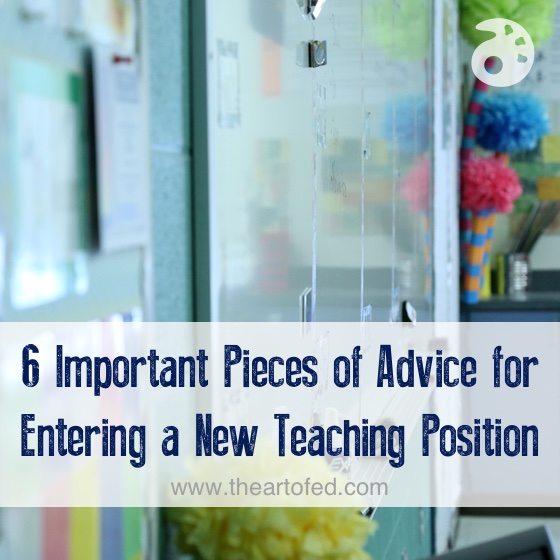While summer vacation brings relaxation for many art teachers, for others, it brings dread. Interviewing, getting a new room ready, and thinking about meeting a whole new set of coworkers and students is enough to make any art teacher want to hide in a corner.
I recently spoke with Killian Williams-Morantine, an art educator from rural Louisiana, about this very topic. So many art teachers will be in new environments this fall, and I wanted to share some of Killian’s sage advice.
I first met Killian at the 2015 NAEA Convention and was struck by his story of entering a tricky teaching position and winning over the staff and students. I thought, “Wait, isn’t this every art teacher’s issue at one time or another?”
Whether you’re entering your very first teaching position, switching schools, or switching districts, there’s advice here for you.
Meet Killian

Killian came to his current position from a fast-paced, ever-changing background and the big city of Lafayette and landed in the middle of rural Louisiana. Namely, he landed in West Feliciana Parish, an area of Louisiana that’s known for plantations and Civil War sites. The entire region has 15,500 people and is serviced by one school district. It is here that Killian comprises the entire high school art department. Talk about culture shock!
Killian had some work to do when he arrived as the students didn’t know what to make of the “city guy” standing before them. Through hard work, persistence and an infectious drive to win people over, Killian now runs an incredibly successful art department. Here’s what he had to say.
6 Important Pieces of Advice for Entering a New Teaching Position

1. Remember why you became a teacher in the first place.
Although many college students try out a few different majors, Killian’s journey to becoming an art teacher is on a whole other level. Holding every job imaginable from jailer to database programmer, waiter to cultural correspondent in Nigeria, Killian finally landed at art teacher, and things felt right. Killian says, “The main factor in what led me to becoming a teacher was my desire to help others. Teaching is a vocation and a service. Teaching is good for me, for my character, and I really feel I am in the right place.” So, even if everything goes wrong on your first day or in your first week, keep your eye on the prize. Remind yourself why you chose to become an art teacher in the first place.
2. Know that it’s normal to feel nervous.
I asked Killian, member of the U.S. Army National Guard, how he felt going into a new teaching environment on the first day. His response? “Nervous! Terrified! I was sweating through a suit jacket.” And, what did he say he was most nervous about? The kids! He likened it to starting high school for the first time and being the “new kid.” Anyone who has entered a new teaching position can relate to this feeling. Know if you’re feeling apprehensive too, you’re not alone.
3. Don’t be afraid to ask questions!
When I started teaching, this was the most difficult piece of advice for me to take. I thought that asking a question would make me look silly or uninformed. Looking back, it was foolish to think that I would know how to use the copy machine or know where the extra thumbtacks were kept without asking. I was an art teacher, not a psychic! As Killian points out, “Your workplace has a culture all it’s own.” Seek out one or two helpful people you feel you can trust and ask away.
4. Make sure to develop a support system for yourself.
Although Killian is married to another art teacher (cool, right!?) he says, as an art teacher, you are often “flying solo.” It’s unlikely that you’ll have another art teacher in your building, especially at the elementary or middle school level. So, what to do? Killian has this advice, “Focus on developing a connection with other faculty, but more importantly, make connections with parents and the community.” During your first year, find a few extras to attend where you can mingle with these groups. You don’t want to burn yourself out doing too much, but you do want to start building relationships with the people that will support your program. Try chaperoning a school dance, attending a school board meeting, or helping to design the homecoming float.
5. Be prepared for an adjustment period with the students.
Like Killian, when I started at my second school, the kids were not too happy about it. The previous teacher had been a lot more lax with classroom management, and I was getting a lot of pushback. Every day I heard, “But Mr. so-and-so always let us do_____!” I chuckled when Killian told me, “I remember once telling a group of rowdy students, ‘This is it. I’m it.’” I could so relate! However, if this happens to you, it’s important to realize that you’ll have different strengths than someone else, and that’s ok! Within a few weeks, my students were happy to go along with the new routines and started saying things like, “Mrs. Heyn, I like how it’s so organized in here. I can always find my art!”
6. Think carefully about how you present yourself to the staff and students.
Appearance can go a long way in helping kids see you as the professional you are. Killian took to wearing simple, serious, skinny neckties that fit his personal style. Kids took notice. “Mr. Williams-Morantine, only you and the principals wear ties. What’s up with that!?” they asked. Think about how to convey your personal style in a professional way.
In addition to all of these suggestions, Killian also advises you to take some time to make art. It’s therapeutic to lose yourself in a piece or a project after a trying day. Finally, Killian has this to say, “When it comes to your classroom and program, think outside the box. Your class is going to be called the “fun” class. Make sure it lives up to this name, but also ensure learning is happening. It is important to create a safe place for all your students.”
Thank you so much, Killian, for sharing your story and advice with us!
Are you entering a new teaching position this year? How are you feeling?
If you’ve been in this situation before, what advice do you have to offer?
Magazine articles and podcasts are opinions of professional education contributors and do not necessarily represent the position of the Art of Education University (AOEU) or its academic offerings. Contributors use terms in the way they are most often talked about in the scope of their educational experiences.





